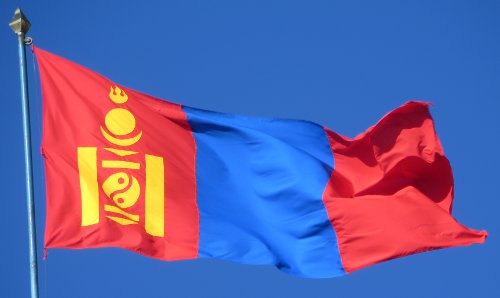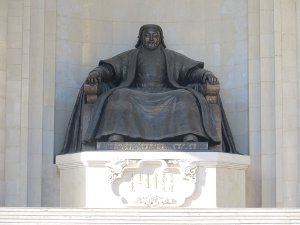Best of Mongolia

We arrived at Mongolia on September 17, 2013 without too many plans of exploring this country for long, until unexpected visa issues at the Russian Embassy became the most profound opportunity to stay longer and fall in love forever with this magical land of endless open steppes, fresh smell of grass, immense blue sky, beautiful children with rosy cheeks, wild horses, and unforgettable sunsets. We stayed in the country until October 4, 2013, spending a total of 18 days traveling around their current capital, Ulaanbaatar, the ancient capital, Kharkhorin, the countryside of central Mongolia, and the national parks of Khustain and Terelj. A lot was left undiscovered and waiting for us to come back!
Mongolia’s identity is strongly attached to the stories of their invincible empire and national hero, Chinggis Khaan. Under his ruling multiple laws were created, Khaan created the first intercontinental free-trade zone, he declared the law that protected ambassadors with diplomatic immunity to prevent them from being killed and tortured, he also declared freedom of religion to decrease the intolerance and violence, and his empire was the largest the world has ever known, from Beijing to Turkey. Like Chinggis Khaan, many Mongolians today, continue living a nomadic lifestyle in the countryside, moving around regions and raising free livestock of sheep, goats, cows, camels, and horses.

The ger is the perfect housing designed for the nomadic way of living that has retained its originality throughout the centuries. During our trip we were fortunate to spend some nights sleeping in a ger, one of those with a nomadic family in central Mongolia. Our experience with them was peaceful and full of novelties: horse riding to move the livestock, watching how horses are milked, and drinking horse milk all day long. Enjoying sheep meat (mutton) in most of our meals, cream, biscuits, khuushuur, and drinking milky tea and Mongolian vodka to keep us warm were of the memorable foods we had. Living with people we learned about their traditions, communicating without the need of words, feeling embraced by their countless gestures of hospitality, and finding out our fortune while throwing the ankle bones.
Since ancient times the natural and climatic conditions of Mongolia were suited for nomadic animal husbandry and hunting management. But when Buddhism spread across the country in the 16th century, many monasteries were built and accordingly some portion of the population settled down permanently or semi-permanently. Before Buddhism, Shamanism was the traditional and most widely belief system practiced. Until today, these two forms of spirituality are still co-existing and practiced. From 1921 to 1990, Mongolia was a Communist country and all social sectors including economy, culture, and politics were directly dependent on the Soviet Union. All religious practices were abolished in Mongolia in 1973 during the communist purges. During this dark period, many Buddhist temples were destroyed and monks were persecuted and assassinated. Citizens faced multiple prohibitions preventing them from moving freely within their own country, political leaders pushing for independence were killed, and families starved for years while surviving with the minimum. With the democratic revolution and the massive request of students, workers, monks, youth, and democratic leaders, Mongolia attained independence and democracy in 1991. We were excited to hear stories and memories about the recent political and life changes of this nation from people that actually when through them. Mongolia’s history has been shaped by endurance of conflicts and economical domination of two neighboring countries, China and Russia. Until today, despite the booming mining industry in Mongolia and it’s rising economy, the nation still depends on Russia and China to access imported food and oil necessary to keep the country running.
We left Mongolia dreaming with the colors of the summer days when we hope to return, picturing ourselves walking and horse riding around its extensive green carpets, once again feeling the openness and happiness of nature and life as it should be!
Below are other great things we enjoyed about Mongolia:
Food and Drinks
Buuz: Mongolian Dumplings
Beef Soup with Flatbread
Chinggis Khan Beer
Gem Draft Beer
Horse Milk
Chinggis Khaan Vodka
Khuushuur: deep-fried meat pancakes
Dumpling Soup

Favorite Sights and Activities
Spending a Night at a Ger with a Nomadic Family in the Countryside
Hiking through Terelj National Park
Watching Traditional Mongolian singing and dancing at Tumen Ekh
Viewing the Przewalski Wild Horses at Khustain National Park
Horse Riding in the Counrtyside
People
Agee, Enkhee, and daughters (Sako and Oka): from Mongolia, not only our CouchSurfing hosts in Ulaanbaatar, but our new family. We shared many laughs and stories together and were kind enough to take us on day trips.
Guillaume and Laure: from France, met while CouchSurfing with Agee and Enkhee.
Stano: from Slovakia, met on the bus to Kharkhorin and traveled with him for a couple days.
Fabian and Natalie: from France, met while CouchSurfing with Agee and Enkhee.
Animals Viewed
Domesticated Horses
Takhi or Przewalski Wild Horses
Marmots
Sheep
Goats
Camels
Cows
Yak

Native Words
Yamaa = Goat
Khoni = Sheep
Mori = Horse
Temee = Camel
